
A Visit to the Newly Renovated UC Davis Bee Haven
It's All A'Buzz with Bees, Other Pollinators, and Many Projects
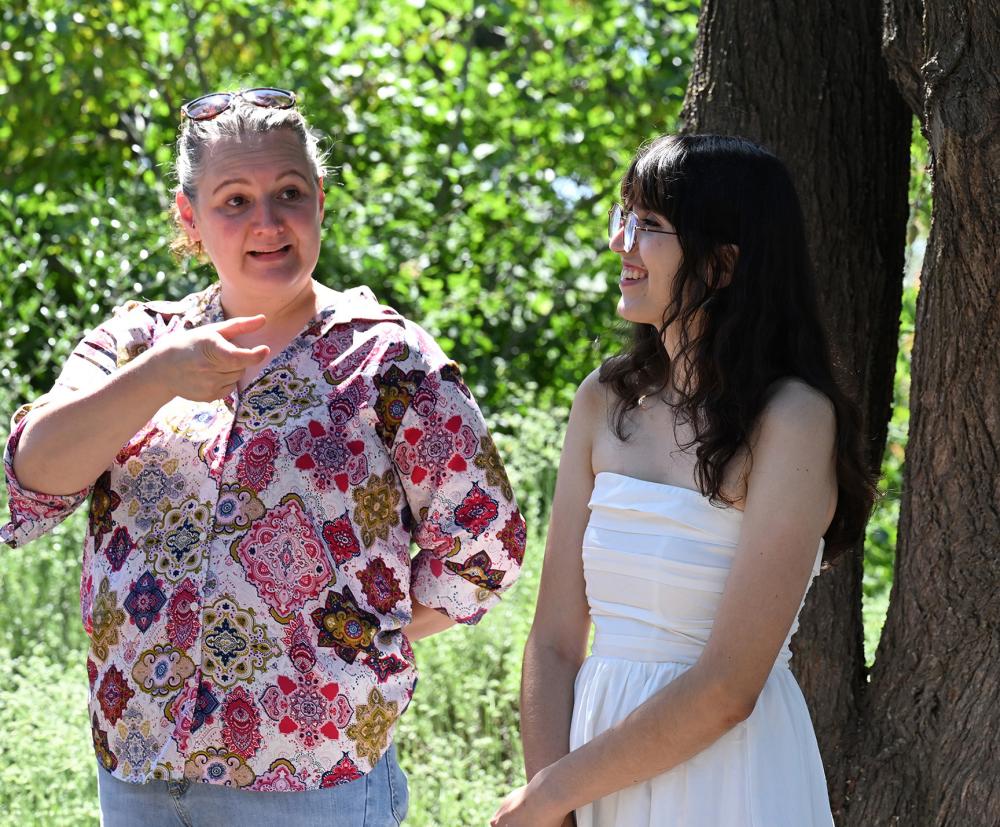
See Photo Gallery
“A hidden gem.”
That’s how the Vacaville Museum Guild president described the UC Davis Department of Entomology and Nematology's newly renovated UC Davis Bee Haven.
The half-acre bee demonstration garden, installed in 2009 on Bee Biology Road, next to the Harry H. Laidlaw Jr. Honey Bee Research Facility, has sprung to life with more plants, more pollinators, and more projects since its renovation launched last summer.
The Museum Guild scheduled the tour with Bee Haven director Elina Niño, apiculture professor with the UC Cooperative Extension and a member of the UC Davis Department of Entomology and Nematology (ENT) faculty. She is also the founder (2016) and director of the UC Davis-based California Master Beekeeper Program.
Samantha Murray, education and garden coordinator and Niño led the tour, which included a presentation by UC Davis Distinguished Professor Emerita Diane Ullman, noted entomologist and artist who played a key role in the creation and installation of the art in the garden; pollinator ecologist and native bee expert Neal Williams, ENT professor; and Cari Dubois-Wright, director of development, UC Davis College of Agricultural and Environmental Sciences.
“This was a hidden gem experience,” said Guild president Pat Zetah, a retired teacher. “It’s very nice to have the UC Davis faculty and staff share their time and expertise with us on this visit. The music in the garden was quite lovely and an added bonus to the outing.”
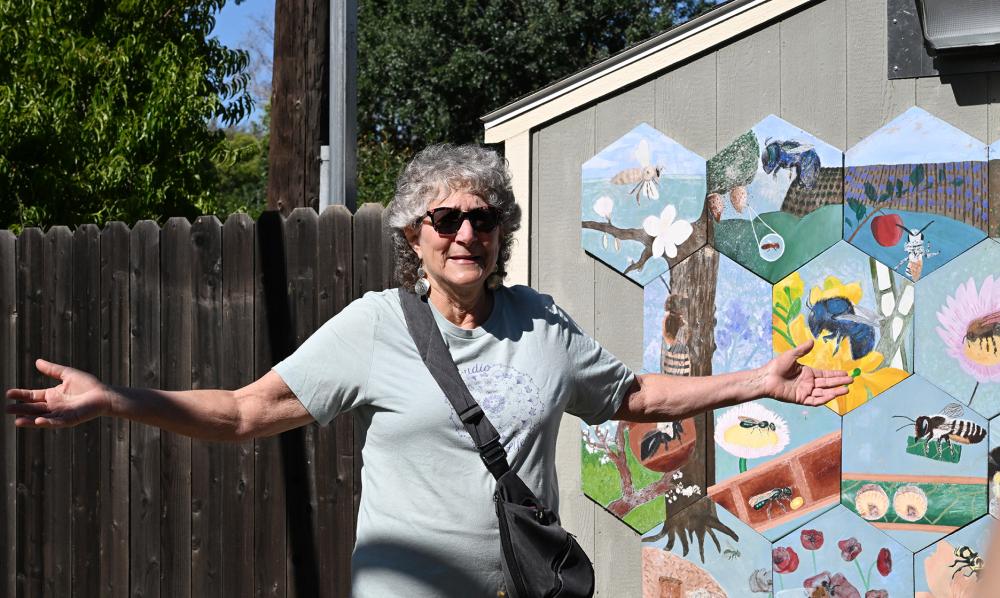
“My biggest take-away is once again, you’re never too old to earn new things,” said Museum Guild vice president Tammy Gullett, in reference to the bee presentations. “I loved how passionate he (Professor Williams) was on the subject (of native bees). Our whole group was given the royal treatment.”
In her talk, Niño related the history of the garden, which, under the direction of Professor Lynn Kimsey (now UC Davis Distinguished Professor Emerita) was installed in the fall of 2009. It was initially named the Häagen-Dazs Honey Bee Haven in reference to its primary donor. In 2010, a year after its installation, the Sacramento Bee named The Haven as one of the top 10 public garden destinations in the region. (The UC Davis Arboretum and Public Garden ranked No. 1.)
In addition to Niño and Murray, the UC Davis Bee Haven team includes Joe Tauzer, manager of the Laidlaw facility, who is in charge of the irrigation system and other Haven projects; and Wendy Mather and Kian Nizad, co-program managers of CAMBP.
“We have more 200 native plants in the garden,” Niño told the group. "It’s the home of honey bees, native bees, butterflies, native bees--and a few ground squirrels.” Native bees? UC Davis Distinguished Professor Emeritus Robbin Thorp (1933-2019) found and identified more than 80 native bees in the garden, she said. California is home to 1600 species of native bees.
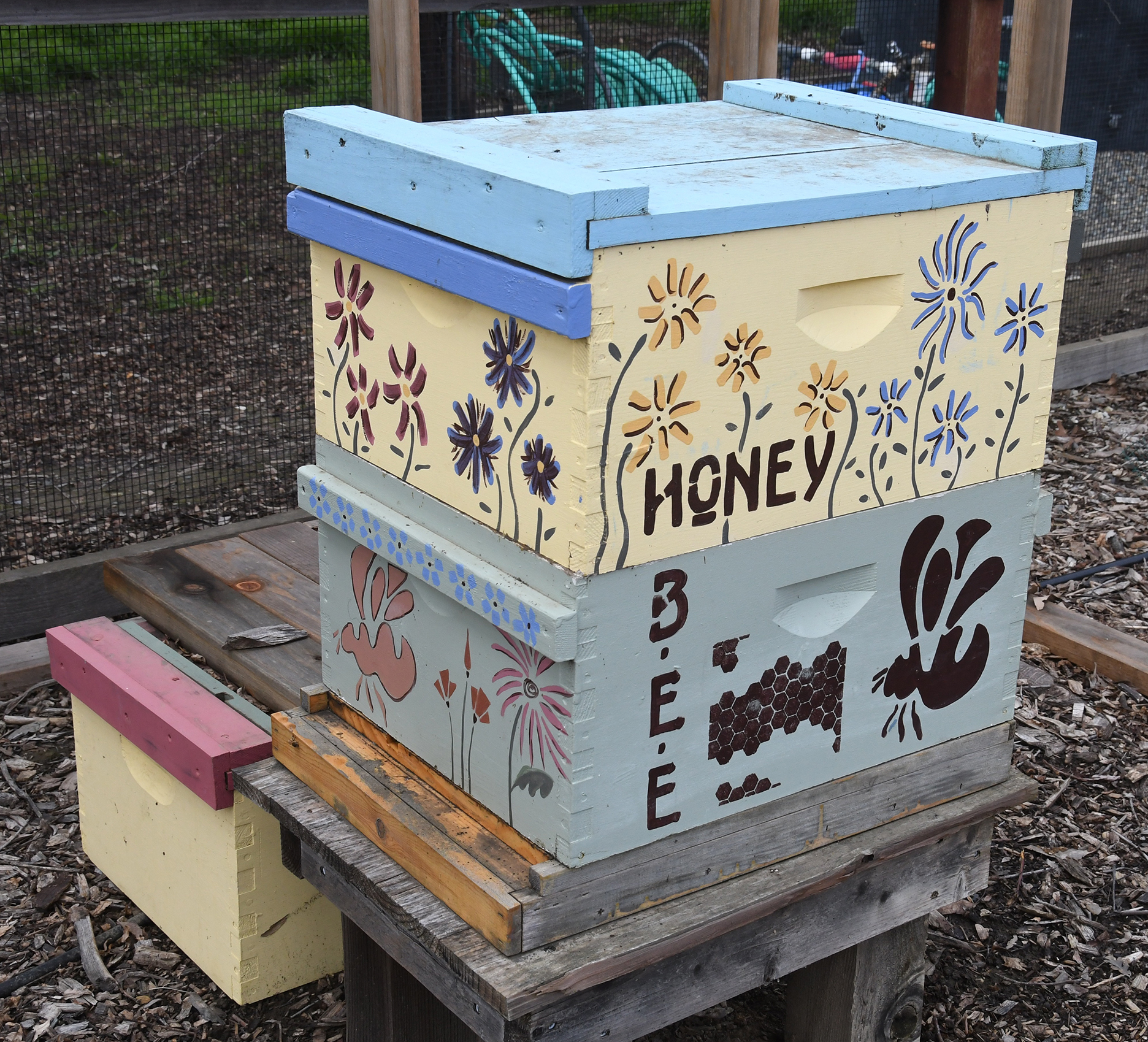
Professor Ullman and educator-artist Donna Billick of Davis are the key figures behind the creation and installation of the art in The Haven. They co-founded and co-directed the UC Davis Art-Science Fusion Program. Ullman, assisted by Billick, taught the UC Davis entomology course, ENT 01, “Art, Science and the World of Insects,” a course fusing science with art. ENT 01 students, along with faculty, staff and community members, created the art in the garden.
A six-foot long ceramic-mosaic sculpture of a worker bee, "Miss Bee Haven," by Billick, anchors The Haven. It includes a bench depicting honey bees in various life stages and engaged in various duties, from nurse bees to foragers.
"The sculpture is forged from bronze, so it's a very durable material," Ullman told the group. "When Donna built the bee, she basically built a metal frame that's hollow, and then she coated the outside of that frame, just like you would be building a boat with a cementitious material. And then the mosaic is installed on that, and the legs and the antennae and the veins in the wings are all bronze.”

A mural of native bees graces the garden shed. The bees range from the tiny sweat bee to the Valley carpenter bee, the state's largest carpenter bee. Then doctoral candidate Sarah Dalrymple, graphics project coordinator and teaching assistant for ENT 01, guided the students in the design, creation and installation of the panels.
Ullman, who retired in 2024 from her 29-year career as a member of the ENT faculty, is also a former associate dean for the UC Davis College of Agricultural and Environmental Sciences. Ullman is internationally known for her research on insect/virus/plant interactions and management strategies for insect-transmitted plant pathogens. A Fellow of both the American Association for the Advancement of Science (2014) and the Entomological Society of America (2011), Ullman was named the 2014 recipient of the Entomological Society of America’s Distinguished Teaching Award.
Professor Williams, widely known for his expertise on native bees, discussed the diversity and biology of native bees. Speaking in lay language, he began by saying that honey bees are “the cornerstone of agricultural pollination…but there's also this whole bunch of native species that are out there, and they also make really important contributions to crop pollination in California, nationally and worldwide."
Some native bees are more effective than honey bees on certain crops, Williams said, citing the alfalfa leafcutting bees (Megachile rotundata) on alfalfa, and the bumble bees on tomatoes. Bumble bees are "pros at buzz pollination," which involves vibrating or shaking the flowers to release pollen.
"What's weird about the tomato plant are two things," Williams said. "One, it doesn't produce any nectar, so honey bees are not particularly motivated to go to it. The other thing is, instead of having a regular anther, it's got anthers that operate like a salt shaker on your table...So the pollen is like the salt and the anther is like the shaker. And the problem is, most bees, including honey bees, don't know how to make that shake."
“So, honey bees don't go to tomatoes because there's no nectar and they can't get the pollen."
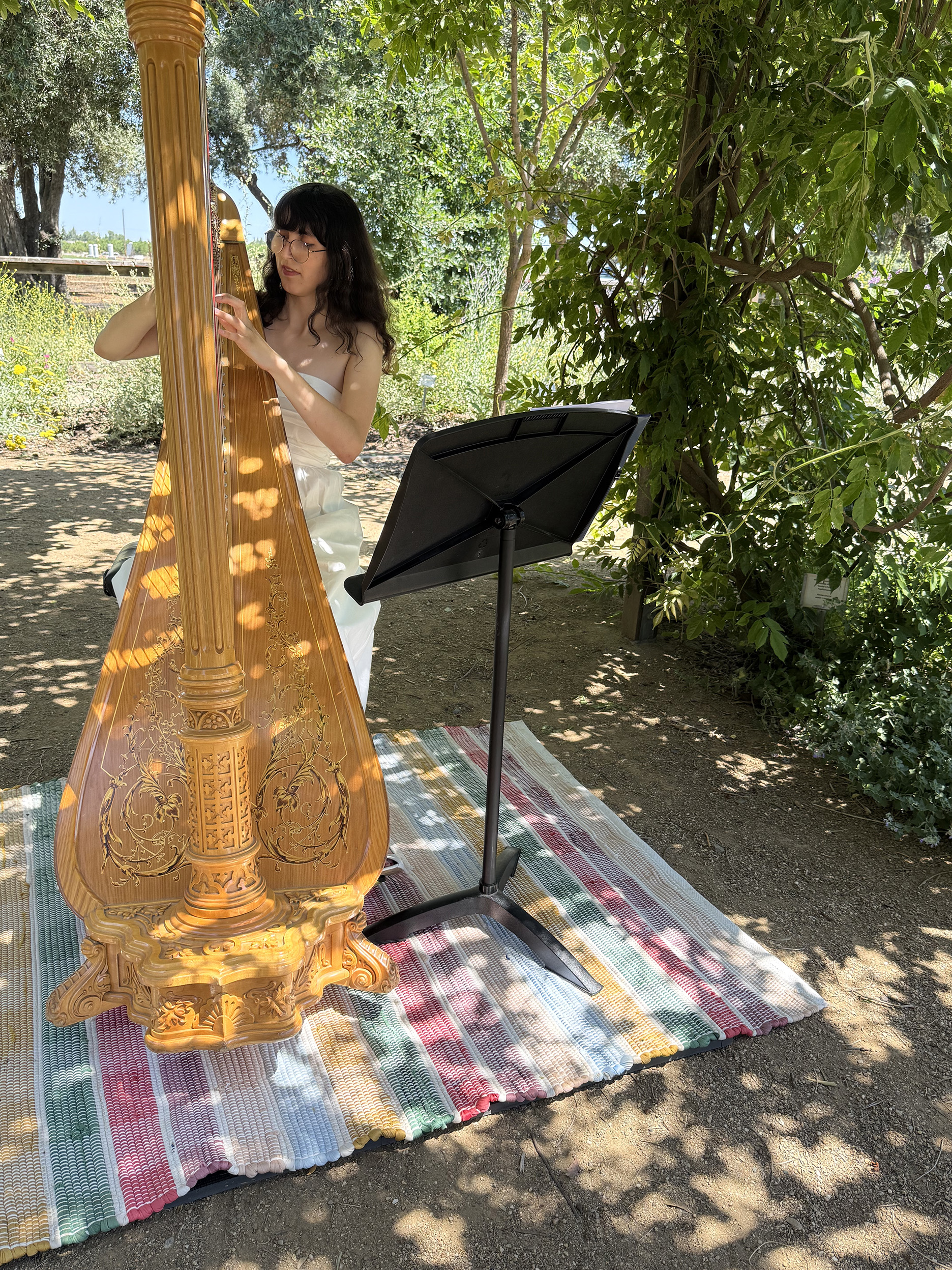
Williams noted that the combination of honey bees and wild bees "can lead to more effective pollination than either group alone." An example: strawberries.
Williams, a member of the ENT faculty since 2009, is a Fellow of the California Academy of Sciences and a Chancellor’s Fellow alumnus.
During the lunch break, Murray, a member of the UC Davis Class of 2025, performed on the harp, presenting En France: L’éternel rêveur by Marcel Tournier; The Victorian Kitchen Garden Suite by Paul Reade (harp solo only): and Habanera Gris and Danza de Luzma by Alfredo Rolando Ortiz
Murray, who recently received her bachelor’s degree in music, wears a number of hats. She's the education and garden coordinator of The Haven, a musician (she plays both the harp and flute) and a beekeeper with expertise in installing pollinator gardens.
Her UC Davis career included performing with the Concert Band, Jazz Ensemble, Symphony Orchestra, Flute Choir and the Harp Ensemble. Her senior recital, illustrating her passion for bees and music, appears on YouTube. At the 18:02 mark, she begins introducing "a very special composition titled Lebah Menari (Dancing Bees), which I created in collaboration with Heni Savitri, the director of the UC Davis Gamelan Ensemble. This piece is particularly meaningful to me as it weaves together my passion for the harp, my admiration for bees, and the rich beauty of Javanese music. The lyrics are sung in Javanese and celebrate the movements and contributions of bees."
Murray initially became involved with the UC Davis Bee Haven last summer while serving at the Laidlaw facility as a lab technician for Richard Martinez, a Niño graduate student researching nutritional diets for bees.
“What I admire most about bees," Murray says, "is their remarkable work ethic and the essential role they play as pollinators, supporting ecosystems and agriculture alike."
Ongoing Plans and Future Plans
Ongoing and future projects at The Haven include:
- A new “UC Davis Bee Haven” sign
- Educational shadow boxes
- New educational boards (less text, more visuals)
- Signage for self-guided tours (videos, text, voice narration via QR codes)
- A garden overview video (plant/bee/butterfly/bird statistics)
- Addition of more native bee condos and shade-tolerant plant species
- A window in the garden shed for visitors to view a honey bee observation hive and information panel
- More garden beds
- More art
- More benches and tables
- Classroom visits
- Kids' materials, including bee facts, to be housed in the garden shed
- Garden scavenger hunt
- Improvements to the hummingbird area and plant selection in shaded areas
- Repurpose the almond tree trunk: hollow it out and turn it into a bee home
Infrastructure
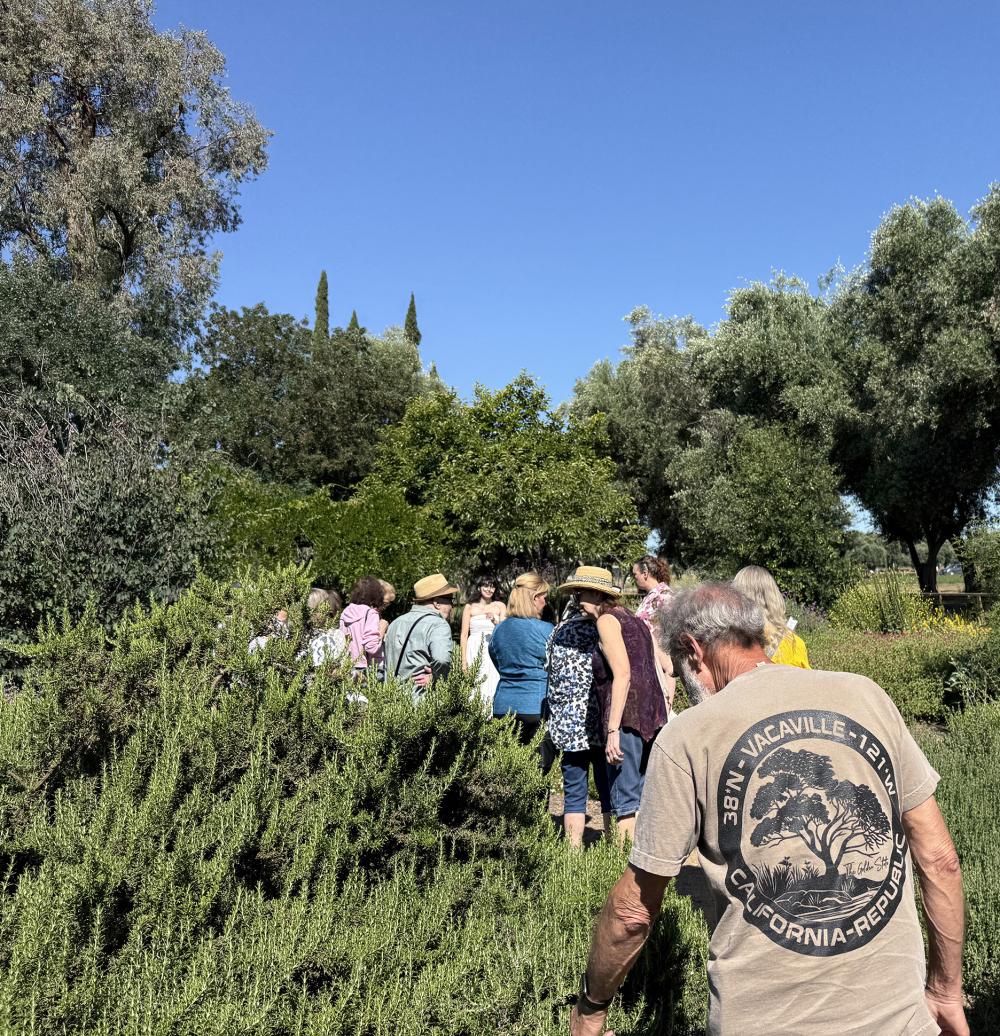
Many more ideas are being considered, Murray said.
CAMBP co-program manager Wendy Mather commented: "I would love to see more art / sculpture and maybe a return of the sundial."
The Bee Haven is open from dawn to dusk. Admission is free. The first hour of parking is free, as announced by UC Davis Transportation Services.
Public Donations
The UC Davis Bee Haven's only sources of financial support are public donations, Dubois-Wright noted. The Haven, considered a vital resource for pollinator education, research and conservation, seeks financial support for program development, maintenance and educational programs and to ensure "a thriving future for pollinators." To donate, access https://give.ucdavis.edu/AENM/GRDNBEE. Contributions are tax-deductible. Or, year-around donations to the Haven can be mailed to:
UC Davis, Advancement Services
Attn: Debbie Norden
202 Cousteau Place, Ste 185
Davis, CA 95618
Checks should be made out to UC Regents, and on the memo line, write “Deposit into 3-GRDNBEE.” For more information, contact Cari DuBois-Wright at caduboiswright@ucdavis.edu.
Volunteers are also needed. For more information on the volunteer program or tours, contact Elina Niño at elnino@ucdavis.edu or Samantha Murray at samurra@ucdavis.edu.
